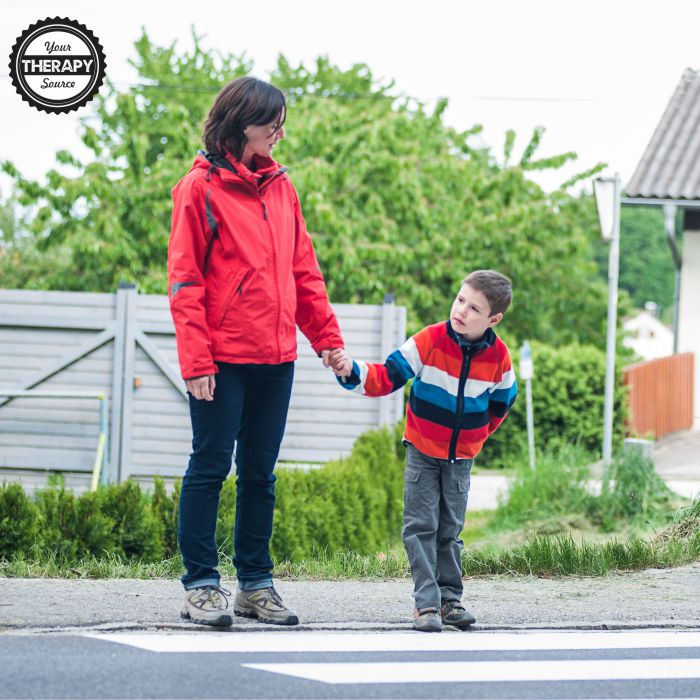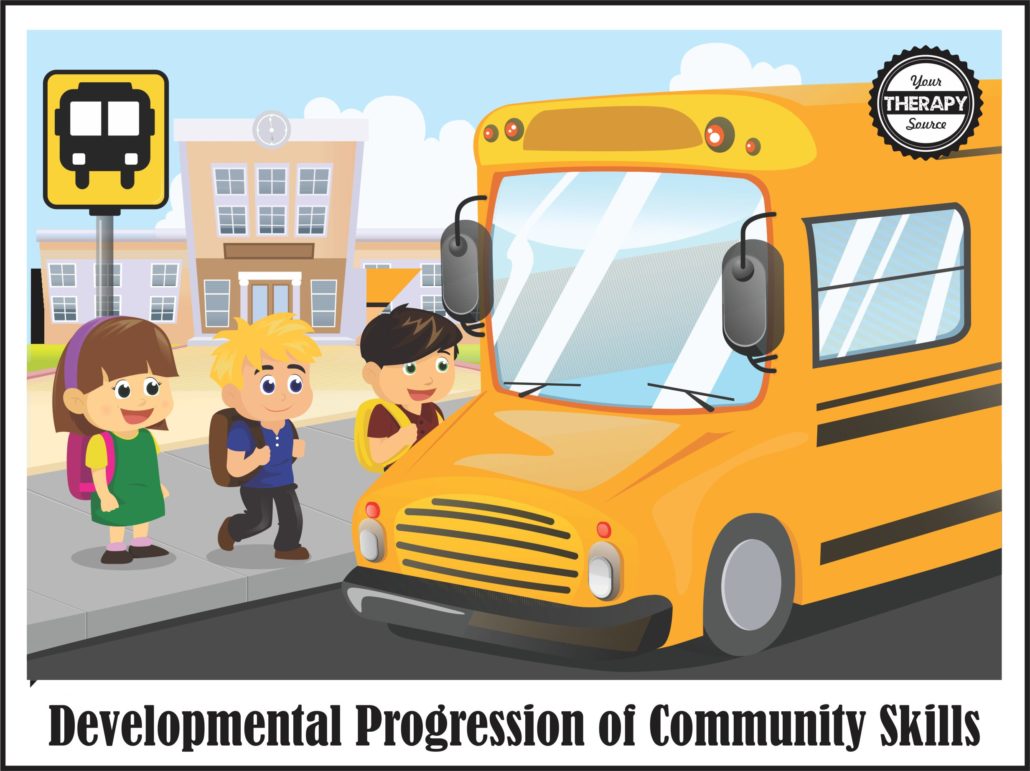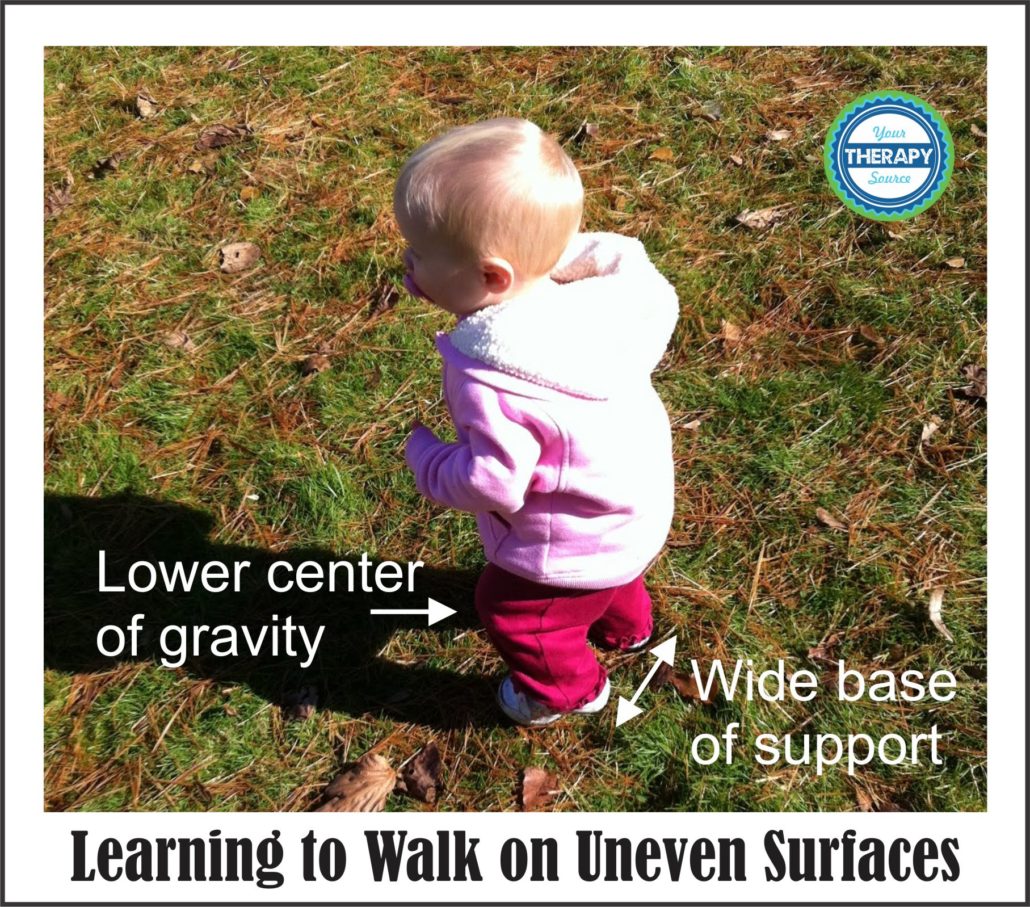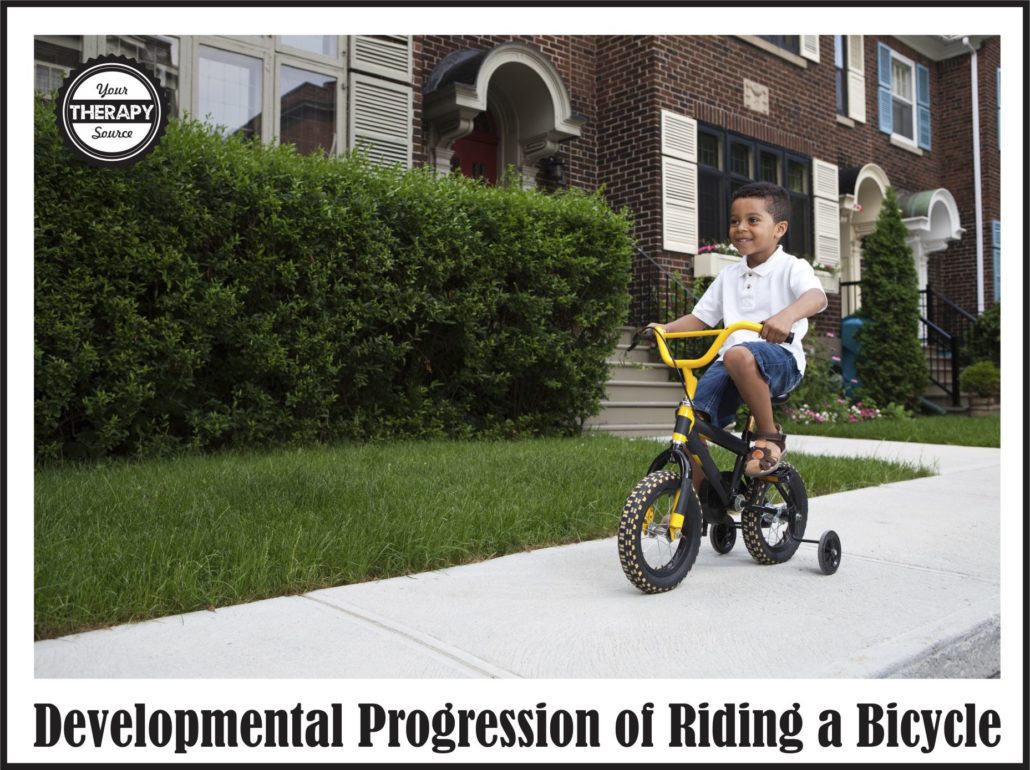Crossing the Street, Riding a Bike and Other Community Skills
The ability to complete the functional tasks of navigating the community, such as crossing the street, develops along a continuum.
Children need motor skills, visual perceptual skills, balance skills and safety awareness to be independent in the community.
The developmental progression of the following community skills will be addressed: walking up/down ramps, curbs, different surfaces, bike riding, crossing streets and on/off different modes of transportation.
DEVELOPMENTAL PROGRESSION OF WALKING ON DIFFERENT SURFACES, UP/DOWN RAMPS AND CURBS
After children have moved through the developmental progression of rolling, crawling, standing and walking higher level motor skills begin to be mastered.
Children normally learn how to walk on level, flat surfaces. When the flooring changes from hard flooring to rugs children need to adapt and lift those little legs just a little higher to clear the rug.
When a new walker heads outdoors, uneven surfaces require additional righting reactions and balance skills. The feet tend to separate to widen the base of support and the knees may bend to lower the center of gravity.
Around 18 months to 24 months+, some children will begin to step on and off a curb without a hand hold. Jumping down from the curb (with one foot leading) quickly follows. Children develop the ability to safely go up and down ramps around the same developmental age. Children can swiftly and safely run up and down ramps around 2-3 years of age.
If you need more information about childhood development in this younger age range, check out The Infant and Toddler Handbook. Written by Lauren Drobnjak PT and Claire Heffron MS, OTR/L, this 30-page downloadable ebook is packed with reader-friendly information about the developmental motor milestones you can expect in kids ages 0 through 5.
DEVELOPMENTAL PROGRESSION OF BIKE RIDING
First, children learn how to propel a ride on toy around 18-24 months with their feet and progress to pedaling a tricycle around 36 months of age.
Around 5+ years of age, most children have developed the coordination, balance and motor planning to ride a bicycle without training wheels. At this age though, safety awareness is a concern in terms of avoiding obstacles and cars so close supervision is a must with significant practice time.
Around 6 years+ of age, children begin to develop improved safety awareness but are still at risk for injuries and can use hand brakes.
Around 9-12 years of age, children can shift gears on a bicycle and are fairly aware of traffic laws.
Children under age 10 ride primarily on sidewalks, playgrounds, and neighborhood streets. Bicycle riders over age 10 are more likely to be found on neighborhood streets, bike paths, or major thoroughfares.
CROSSING THE STREET

As children get older and begin to explore their communities, sometimes parents think children are able to handle traffic safely by themselves before they may be ready. Young children cannot reliably and consistently accurately judge the speed or distance of oncoming cars. Children under age 9-10 should cross the street with an adult. Remind children not to cross the street with head phones on or ear buds.
From a young age, teach and practice with children to:
- look left, right, then left again before stepping into the street.
- cross the street at designated crossings.
- cross only when there are no cars coming.
- walk on the sidewalk.
- walk on the side of the street facing traffic if there are no sidewalks.
- recognize crossing signals.
- be extra cautious when crossing where cars are parked on the street. Avoid crossing in between parked cars.
GETTING ON AND OFF THE SCHOOL BUS
By four years of age, most children can go up and down regular sized stairs without using a handrail. To get on/off the school bus, children need to to be able to independently climb up and down taller bus stairs using the handrail. Most children are able to do this by kindergarten age. There are no standard, specific age guidelines for when children are developmentally ready to wait, get on or get off a bus independently. When children do start to ride the bus it is important to teach and practice with children to:
- stand at least three giant steps (6 feet) away from the curb.
- walk on the sidewalk or along the side of the road until you are five giant steps (10 feet) ahead of the bus if you have to cross the street before getting on the bus.
- make sure the bus driver can see you and you can see the bus driver.
- never walk behind the bus.
- never try to pick it up anything you dropped until you get permission from the bus driver.
Children will develop at their own pace independence with life skills through education and practice.
Resources to Help Children Develop Life Skills
Need to track progress regarding an individual’s independence with various life and community skills such as safety awareness, transportation, community skills and more? Check out Life Skill Checklists.
The 14 life skills checklists include: Dressing Skills, Personal Hygiene, Mealtime, Food Preparation, Chores, Safety Skills, School Routine (free!), Before and After School Routine, Personal Health, Interpersonal, Transportation, Self Advocacy, Community Life Skills and Pre-Vocational. FIND OUT MORE INFORMATION.
The My Information Binder digital download helps children learn important life skill information. Students can practice matching or handwriting their names, address, phone number, emergency info, school info and more. This 29 page PDF black and white, digital document is delivered electronically immediately following payment. The picture images are suitable for all ages.
References:
Boyse, K (2009). Safety Out and About Walking, Biking, Scooter, School Bus and Shopping Cart Safety. Retrieved on 7/26/16 at http://www.med.umich.edu/yourchild/topics/outabout.htm.
NHTSA. School Buses. Retrieved on 7/26/16 at http://www.nhtsa.gov/School-Buses
Rodgers, G. Ph.D. Bicycle Study – Consumer Product Safety Commision. Retrieved on 7/26/16 at http://www.cpsc.gov//PageFiles/112701/344.pdf.
Smith, T. (2002) AGE DETERMINATION GUIDELINES: Relating Children’s Ages To Toy Characteristics and Play Behavior. Retrieved on 7/26/16 at https://www.cpsc.gov/PageFiles/113962/adg.pdf
Teaford, P et al (2010). HELP® Checklist 3-6 Checklist. VORT Corporation.






Comments are closed.